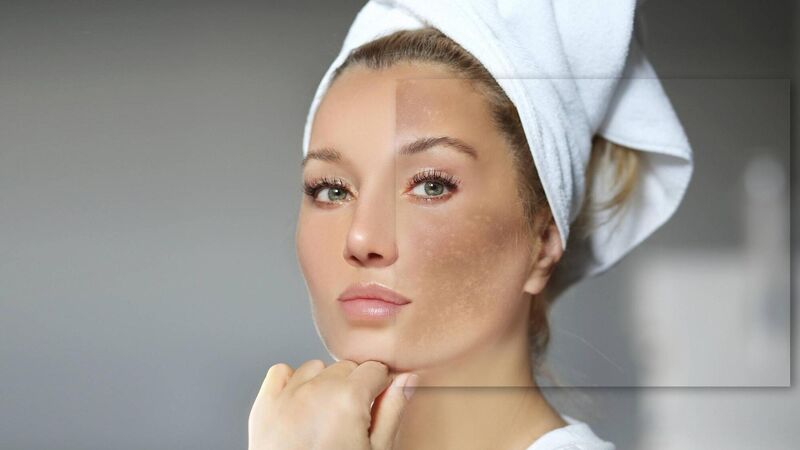The Skin Nerd: What you need to know about age spots, patchiness, or pigmentation

The Skin Nerd: Age spots, patchiness, pigmentation – and ANOTHER reason you should always be protecting your skin from UV rays
Do you suffer from age spots and patchiness in colour around the eyes, cheeks and nose, which doesn’t seem to improve? If this sounds like you, this could be pigmentation predominantly related to UV rays.
Tackling skin pigmentation takes time, but it does not need to be hard. When it comes to pigment, a prevention first approach is best, so always protect the skin with a broad-spectrum SPF and antioxidant-rich formulas. Remember that, even if it feels too late to start, it really is not.
Always use a dedicated daily sunscreen, as opposed to a moisturiser or makeup with SPF, and ensure that you apply the correct amount (and reapply every two hours) to prevent pigmentation forming, and stop any existing pigmentation from worsening.
Begin by incorporating vitamin A into your skincare routine. Though many people have heard of vitamin A’s amazing abilities when it comes to anti-ageing and oil control, some are unaware of its ability to help with pigmentation.
I recommend starting with retinyl palmitate, the fatty form, as it’s gentler on the skin but still produces impressive results and with time, I believe it can greatly assist with pigmentation.
It’s also an antioxidant and so protects the skin from oxidative stress caused by free radicals whilst supporting healing processes and repairing the skin.
My top vitamin A recommendations are the Environ Skin EssentiA Vita-Antioxidant AVST Moisturiser range (€57 - €62, theskinnerd.com and environskincare.com) and the brand new Skingredients Retinol 0.6% + B3 Anti-Ageing Serum (€49, skingredients.com, meagherspharmacy.ie and other leading pharmacists).
The next step is to ensure that you are including brightening ingredients in your skincare regime.
The core type of brightening ingredient you are looking for is known as a tyrosinase inhibitor.
This clever ingredient halts tyrosinase, an enzyme that allows the synthesis of pigment.
Put more simply, this type of ingredient inhibits the process, and reduces the likelihood of pigmentation forming.
Luckily, many skincare ingredients are tyrosinase inhibitors, including vitamin C and liquorice root extract.
I recommend Murad Rapid Age Spot Correcting Serum (€90, arnotts.ie, theskinnerd.com and murad.com) as a targeted treatment that helps to even skin tone, brightening and boosting radiance.
I also rate IMAGE Skincare Iluma Brightening Serum (€54.50, imageskincare.ie, millies.ie, theskinnerd.com) for its daily glow-boosting powers.
Simply apply to cleansed skin, morning and evening to help fade dark spots and leave skin hydrated and dewy.
To target pigment from the inside, look to include vitamin C within your diet via foods such as oranges, broccoli and guava.
If you struggle to get your vitamins through your diet, a supplement such as Solgar Ester-C Plus 1000mg Vitamin C (€42.36, solgar.com and theskinnerd.com) can help.
As we do not make this important vitamin ourselves, being proactive when it comes to topping up our levels is essential to both our skin health and general wellbeing!
The next thing to think about is increasing exfoliation. I recommend avoiding gritty products like scrubs, as these can be harsh on the delicate skin barrier.
They simply won’t bring the same level of brightening benefits that exfoliating acids, like lactic acid can have.
Use a glycolic or lactic acid exfoliating cleanser 2-3 evenings a week or every night (depending on the strength – always follow the manufacturer’s instructions to the word!) to boost skin cell turnover.
NeoStrata Foaming Glycolic Wash (€30, neostrata.ie, theskinnerd.com and lookfantastic.com) includes a potent 18% glycolic acid together with 2% lactobionic acid, so it’s high strength and likely to be highly effective.
It is vital that you go easy and don’t overdo it with acids as they can be drying on some skins and can also cause irritation if used too frequently. If you do find these drying, ensure you hydrate the skin afterwards.
Finally, be prepared to give your skin time and have patience. The pigmentation you see may have been formed after years of UV exposure, so it will likely take time to see major improvements. After around 28 days, you are likely to see a difference in your skin.
This is because this is the length of the average skin cycle, but you should see more dramatic results after about six months.

Subscribe to access all of the Irish Examiner.
Try unlimited access from only €1.50 a week
Already a subscriber? Sign in
CONNECT WITH US TODAY
Be the first to know the latest news and updates






